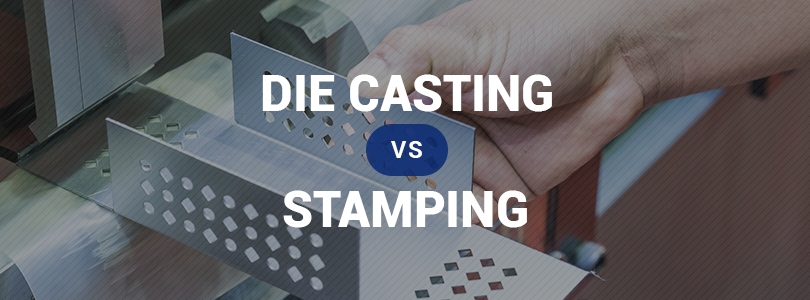
If you need manufactured metal parts, you may be wondering if and when metal stamping is appropriate for your needs. To determine this, it will help to know about both of these metal-part forming processes and how they are typically used, with the advantages and disadvantages.
Metal Forming Processes Explained
Metal forming is when you take metal — which can either be molten or still in a solid state — and form it into a specific shape. There are numerous ways manufacturers can complete this task, each with its benefits and distinct applications.
Metal stamping and die casting are two examples of metal forming processes common throughout many manufacturing operations. When to use die casting versus metal stamping will often depend on the nature of the parts you need.
Die Casting
Die casting is one of the most popular forms of metal shaping today due to the efficiency and technology employed to create quality metal parts. The process of die casting involves:
- Clamping: Clean and lubricate the die, then clamp both sides using high pressure.
- Injection: Force molten metal into the closed die.
- Cooling: Pressurize the metal as it cools until the part is complete.
- Ejection: Remove the completed and cooled product from the die halves.
- Trimming: Cut off the extra scrap metal left by the runner and sprue.
You will need ingots or billets of material to complete the die casting process. Many industries benefit from using the die casting method, including:
- Electronics
- Aerospace
- Furniture
- Power tools
- Home appliances
- Automotive
- Machinery
- Toys
- Decorative finishes
Metal Stamping
Metal stamping is a much more primitive, although often still effective procedure. A sheet of metal is delivered into a hydraulic or mechanical press that uses a die and high pressure to shape the metal into the desired parts. However, metal stamping involves more than this process alone. It can also incorporate embossing, blanking, punching, flanging and bending. Sometimes these processes are completed at once, though some projects require that they be separated into multiple stages.
In metal stamping, you are not melting the material before forming it. One of the main pros of metal stamping is its speed and efficiency, leading many operations in the following industries to take advantage of its capabilities:
- Automotive
- Lighting
- Medical
- Electronics
- Telecommunications
- Construction equipment
- Household hardware
- Home appliances
- Aerospace
Pros and Cons of Metal Stamping vs. Die Casting
Depending on your application, you may find that one of these methods works better than the other. The differences between die casting and metal stamping make them beneficial for specific jobs and operations.
Die Casting Advantages and Disadvantages
If you need to produce a high volume of parts with any level of complexity, die casting is usually the correct choice. You will have some scrap metal left behind by die casting, but it will be a relatively small amount you can likely recycle easily. Die casting is a highly efficient method for metal forming. Plus, anything made through die casting is more likely to align with your specifications and surface finish requirements.
If you need to make thin-walled components, the die cast process is the way to go. Generally speaking, die cast tooling is cost-effective and efficient, and it can reliably produce both small and large components.
One of the cons of die casting is the requirement of using nonferrous materials, which can be a disadvantage depending on your application. Additionally, the products may have inconsistent densities or porosity from air getting trapped in the die during the pouring process. Lastly, die casting may not be the best choice for low production runs due to the time and expense involved in creating the die.
Metal Stamping Advantages and Disadvantages
Because stamping dies are cheaper and usually last the part’s lifetime, some may opt for metal stamping if they have a large amount of product they need to run off quickly. You can use sheets of ferrous or nonferrous material for metal stamping. Metal stamping works well for either high or low production runs and yields consistent, high-quality parts. This process also offers a high level of automation. Dies used in metal stamping are often lower in price and simpler to maintain.
While you can create complex products through metal stamping, it will require more tools. As more complex tooling is more expensive, metal stamping may not be the most cost-effective option in these cases. The problem is that there is not much flexibility in the shape and thickness of the sheet metal. So, with greater part complexity, you’ll need additional components for the metal stamping process, raising the cost. In general, acquiring the equipment necessary for metal stamping is also a significant investment.
Another issue associated with metal stamping is the large quantities of scrap metal generated, which lowers cost-effectiveness. It’s also challenging to make any changes during production because of the difficulty of altering the die.
Contact Premier for Die Casting Services
If you feel die casting is the more sensible choice for your industrial applications, contact Premier Die Casting. More than 70 years in the industry have helped Premier develop a system combining state-of-the-art technology and expert technicians to produce very high-quality die cast parts in a short amount of time at an economical price. To learn more about the benefits of die casting and how Premier can help your business, contact Premier Die Casting today.


